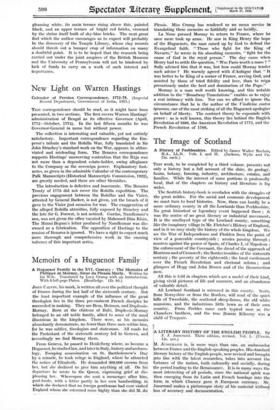The Image of Scotland
25s. each;) -
THIS work, to be completed by a third volume, presents not only a history but a full account of the shire, its geology, fauna, botany, farming, industry, architecture, estates, and families. While the interest of some portions is professedly local, that of the chapters on ' histoly and literature is far wider.
The Scottish history-book is overladen with the struggles of the great nobles. For the social and economic development we must turn to local histories. Now, there can hardly be a more ordinary county in' all the Lowlands than Peeblesshire. No great historical or legendary event happened there ; it was the centre of no great literary or industrial movement. It is the unalloyed type of the Lowland county, something like the imaginary village in Mr. Fletcher's History of England, and in it we may study the hist-ory of the whole kingdom. We see the War of Independence and Flodden from the point of view of a peaceable countryside ; armies passing through ; musters against the power of Spain, of Charles I, of Napoleon ; the enforcement of the Covenant, the dread of the approach of Montrose and of Cromwell ; the Border troubles of the sixteenth century ; the poverty of the eighteenth ; the local excitement over the French Revolution and electoral reform ; and glimpses of Hogg and John Brown and of the Resurrection
men. -
All this is told in chapters which are a model of their kind, giving vivid pictures of life and manners, and an abundance of valuable detail.
All Lowland Scotland is mirrored in this county. Scots, from Morayshire or from the Borders, will read of the quiet hills of Tweedside, the scattered sheep-farms, the old white mansions, and the industrious little town as of their own country. From Peebles came such typical men as the Chambers brothers, and the true Bonnie Kilmeny was a 'child of Traquair.






















































 Previous page
Previous page